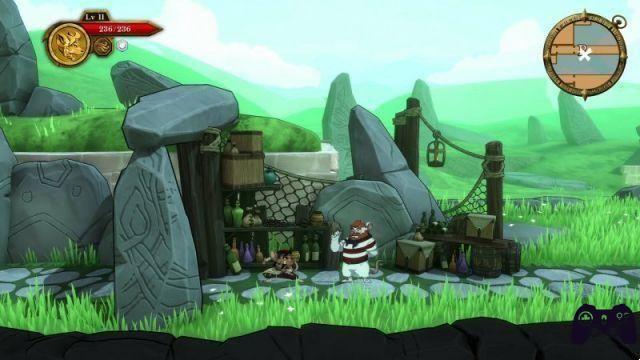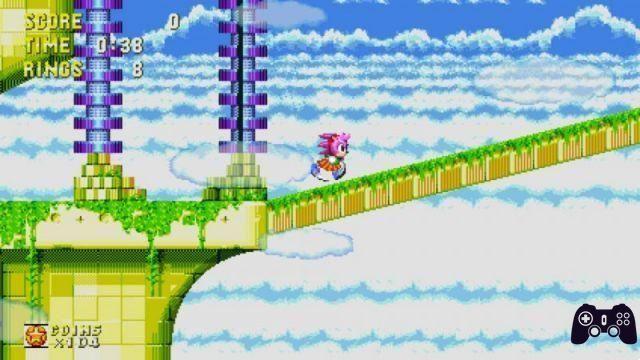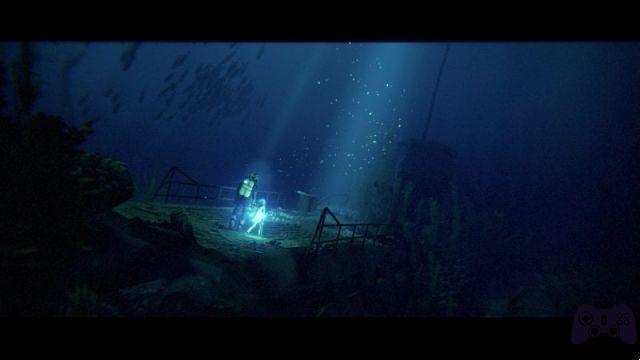Pseudo, a hermit warrior who has distanced himself from the civilized world for who knows what reason, fortuitously meets a strange creature, called "The Boy", who lived with his grandfather, who died in combat. Determined to help the boy, a hairy black ball that looks like a black man mixed with a bird, Pseudo embarks on a long journey that will lead him to face many enemies with characteristics that only the creativity of the Chilean studio ACE Team could conceive, as could the eccentric Zeno Clash, Rock of Ages and The Eternal Cilindro, to name a few of their games. However, if reading these few lines you have heard echoes of God of War, you are not wrong because, as we will see throughout Review, Clash: Artifacts of Chaos seems almost a caricature of Sony's title, Santa Monica. That is, more of a direct criticism of certain design choices.
exploration

There is profound beauty in the tangle of trails and paths that make up the Zenozoik portion, the same world as Zeno Clash, which Pseudo will have to travel to reach his destination. Architecturally and morphologically the lands of Clash: Artifacts of Chaos seem to make little sense, but upon closer inspection they appear as the objective correlate of the protagonist's consciousness, as well as the manifestation of the authors' desire to make the player lose. In every sense. We look out over a ravine and are captivated by the amount of details that make up the shapeless and surreal landscape that we find before our eyes, with which Pseudo merges perfectly in its splendid otherness. He is toothed and has nothing human about him, but he is harmonious in the almost painterly definition of him, a characteristic also underlined by the chosen graphic style, based on pastel colors and contours. Technically there is nothing monstrous, but it is difficult not to be captivated by the general vision that the game conveys, precisely because of its uniqueness.
Once we come to our senses, the first thing we notice is that we are not told what to do or where to go. To orient ourselves we have a very small map available, where Nickname It is represented by a circular icon. Furthermore, we did not find any important reference point to follow. From time to time we see a building appear on the horizon, or it is the path itself that guides us, but getting lost is really easy, between sharp turns, walls to climb, ravines with treasures inside, crossroads without indications, paths that end . against walls and an almost endemic lack of suggestions that ends up weighing especially in those cases in which it is necessary to retrace steps. It's easy to understand how leaving the player at the mercy of Zenozoik's labyrinthine geography, made up of large interconnected areas that load from time to time, is a precise design choice, made in antithesis to those games that keep the player's hand from beginning to end, never allowing it to be completely lost.

Clearly, this is an approach that can be problematic if you don't have a certain taste for exploration and a good tolerance for the risk of going back and forth in search of the right path. Some will find it too indigestible, considering the current standards of the genre. In reality, having accepted the system, we ended up seeing it almost as a consequence of the general style chosen for Clash: Artifacts of Chaos, almost an invitation to participate in the warped magical realism that characterizes the entire Zenozoic, includes the Pseudo: an explosion of muscles on a slender figure with an irregular body.
Combat system

What do you do in Zenozoik besides get lost? Yeah fights, most of the time. At the beginning of the game, Pseudo can choose one of three fighting stances, which greatly modify his attack techniques. During the game he will be able to find new positions, select discarded ones, as well as acquire some special moves that will allow him to increase his offensive potential, in conjunction with the statistics that he can improve by leveling up. His battles are very physical and ideally reminiscent of those of Zeno Clash, although Pseudo is shown in third person and not first person and the battles are less technical, despite the presence of more moves. The harshness of the blows persists, but the third person has evidently recommended greater dynamism, to give meaning to the dodges and the greater space available.
The enemies follow the style of the setting and are a spectacle of their own, among large, stocky and hairy barbarians with heads instead of torsos, among flying creatures that look like pterodactyls designed by Hieronymus Bosch and among other anthropomorphic beings with armor decorated with great tribal taste. . and with a physique similar to that of Pseudo, in addition to the many disturbing creatures such as the boss Gemini, which seems straight out of a Go Nagai nightmare.

In short, the range of enemies is truly rich and varied, to the point that it can be considered one of the strong points of the entire experience. As I already mentioned, I fight They are not very technical. The important thing is to understand when is the right time to attack, between parrying or dodging, studying the enemies' attack patterns. Note that opponents are generally stronger than Pseudo, but much less agile. Therefore, it takes several hits to take them down, while they often need a couple of well-placed attacks to finish the job. In some cases our blows can break those of our opponents, but in others they cannot, so combats often come down to a hit-and-run tactic, in which it is best to stay at a safe distance and attack at the right time. . instead of trying a more aggressive approach, relying directly on close parries and dodges. Especially when you have to face multiple enemies at the same time, this last approach can be decidedly counterproductive.
Rituals of the night and day.

It must be said that, in case of defeat during the day, Pseudo does not die permanently, but rather activates one of his own. night version who can reach the body and awaken it, fighting unique enemies in turn. The nocturnal Pseudo not only has a healing function, so to speak, but also serves to overcome some passages that are impassable for the daytime Pseudo, thanks to its thicker and harder skin, which forms an impenetrable armor, which is not damaged. through the brambles and bushes. On some occasions it is therefore necessary to use it to clear the path of the pseudodiurnal to new areas. The problem is that, in case of death, the nocturnal Pseudo cannot wake up and must recharge from the last checkpoint reached (small camps where it is possible to sleep to change the Pseudo, create healing potions and allocate the skill points that are earned when leveling up). ).
But let's get back to the fight. In addition to the Pseudo Hits, you will unlock several melee weapons during the adventure, either found or purchased from merchants in exchange for the raw materials found while exploring Zenozoik, which will help you a lot against the strongest enemies, even though they often run the risk of breaking at the same moment (each weapon has its own durability).

At the beginning of each battle with intelligent creatures it is possible to participate in a ritual based on the roll of dice (completely optional). Each participant puts an emblem on the plate that penalizes the opponent during the fight in case of victory, then rolls the dice hoping for a good result, using foreign objects to alter it and have the highest possible score or lower the opponent's score. 'other. Whoever has the most points at the end of the ritual prevails. Then we moved on to the fist fight. It must be said that, despite the variety of opponents, in the end the combats become quite repetitive, reducing the involvement a bit, because we tend to use very similar tactics. The bosses break the mold a little, but in general we advance along familiar tracks. There are elements to consider that make the experience more interesting, such as the resistance bar that determines the power of our blows and the damage caused by those we suffer, but some fatigue is inevitable towards the last stages of the approximately twenty hours that we last. They want to complete Clash: Artifacts of Chaos.
A world out of the ordinary

Clash: Artifacts of Chaos is a strange thing. As mentioned, its design seems to continually argue with that of modern action games, presenting less obvious solutions, but at the same time more difficult to digest. There history What counts, although more rarefied than that of other titles, appears deeper and better constructed within the game world, thanks to a series of secondary descriptions and small devices that make the narrative side more present than it seems, among Unexpected encounters, enemies that show their own character, and characters that act in unexpected and interesting ways. The main story itself is not that complex, but the entire context enriches it, including the relationship established between Pseudo and the Child, built in a less banal way than the usual father-son relationship that is recovered from some modern video games.
Conclusions
Tested version PC with Windows digital delivery Steam, epic games store, playstation store, Xbox Store Price 29,99 € Holygamerz.com 8.0 Readers (1) 4.4 your voteClash: Artifacts of Chaos is the classic ACE Team game: stylistically splendid, it asks the player to accept its peculiar dynamic in order to truly appreciate it. Although on paper it is a fairly classic 3D action game with RPG elements, it is worth carefully evaluating its philosophy before deciding whether or not to take on the adventure in the company of Pseudo and the Boy. We liked it, even a lot, but we are aware that some may find some options intended to give the player greater responsibility and autonomy indigestible, which are decidedly nice these days.
PRO
- Stylistically splendid
- It has its own philosophy that is worth knowing.
- We voluntarily lose ourselves in their world.
AGAINST
- The fights tend to get a little repetitive.
- Some design options will not please many






